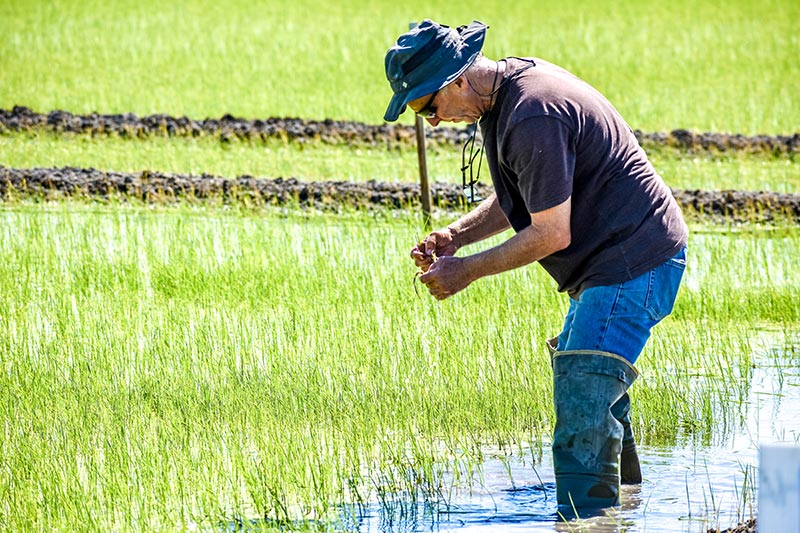Growing Together Summer 2019
Broad-Spectrum Post-Emergence Weed Control Options in Tree Fruit, Nuts, and Vines

For more than 40 years, in tree fruits, nuts and vines, Roundup® and any generic with the active ingredient glyphosate has a been a key component of our weed control programs. However, with continual use of glyphosate, weed resistance can and has developed. There are at least six different weed species that are no longer susceptible to the herbicide. In addition, continual use of glyphosate (or any herbicide) can lead to weed population species shift. We all know that malva (cheeseweed) and filaree are two weeds that are difficult to control with glyphosate alone. With constant use, and less than perfect control, the population will shift with increases in these species.
A second broad-spectrum herbicide we have relied on for many years is paraquat. Sold as Gramoxone and many generics, paraquat is a broad-spectrum, foliar applied contact herbicide. It provides rapid control of both broadleaf and grassy weeds. If applied in full sunlight and warm conditions, paraquat can burn leaf tissue rapidly providing effective control of most species. But paraquat can be extremely toxic and careful procedures must be followed when using the chemical. In addition to the care that must be taken when handling paraquat, there is also confirmed weed resistance to this herbicide (fleabane, annual ryegrass).
In order to prevent the development and the spread of resistant weeds a well-balanced herbicide program is required.
When not using glyphosate or paraquat, an alternative for another broad-spectrum foliar contact herbicide is glufosinate ammonium. Glufosinate ammonium – sold as Rely 280, Life Line and Reckon, among others – is a foliar applied, contact, non-systemic herbicide that provides excellent broadleaf weed control and is good on young grasses. Once a grassy weed gets into the tillering growth stage, control is reduced. There is some discussion about annual ryegrass developing resistance to glufosinate. While this may be, after working with the product for many years, I have found that annual ryegrass has always been difficult to control. Annual ryegrass is primarily susceptible to glufosinate at the early seedling stage of growth, and once the weed begins to tiller, consistent control is difficult.
For improved control of annual ryegrass and other grassy weeds, a tank mix with a grass herbicide like Clethodim (and generics), Poast or Fusilade, can provide broad-spectrum control of both broadleaves and grassy weeds over a wider stage of weed growth than glufosinate alone. There are tree and vine age restrictions with some of these products, so make sure you read and follow label use directions.
To maximize the activity of glufosinate products, there are several key points to remember:
- Application water volume of 30 gallons per acre improves control across several hard to control species (fleabane and grassy weeds in particular).
- The glufoisnate products are generally formulated with an adjuvant. The addition of extra adjuvant does not help with control (unless it is required with a tank mix partner). The adjuvants in most of the glufosinate formulations do tend to foam so the addition of a defoamer is a good idea.
- The addition of a dry spray grade or liquid ammonium sulfate will help with control of certain weed species (velvetleaf and lambsquarter). It will also help with control when the herbicide is applied during periods of moisture stress.
- All glufosinate labels indicate rainfastness after 4 hours of dry time. In addition, we have seen reduced control when applied during periods of heavy dew, especially on grasses or sedges (upright leaves where the dew promotes the material rolling off)
Unfortunately, after glyphosate, paraquat and glufosinate the alternatives for broad-spectrum post emergence weed control products simply don’t exist. Here is where tank mixing various products can help provide a broad-spectrum post-emergence weed control program.
Tank mixes with glufosinate or glyphosate for increased broadleaf weed control:
Treevix:
Strengths: Provides good control of many broadleaf weeds. Excellent on common malva, helps with fleabane
Weakness: No grassy weed control. Can’t be used on grapes. Don’t use on sandy soils
Shark EW:
Strengths: broad-spectrum broadleaf control of small to mid-size weeds
Weakness: Weak on grasses.
2,4-D:
Strengths: broadleaf weed control. Some systemic activity. Tanked mix with any of the broad-spectrum contact herbicides helps with fleabane control
Weakness: Application time of year limited
Goal 2XL or Goal Tender:
Strengths: primarily considered pre-emergence soil applied herbicide. It does have some post-emergence activity. In a tank mix with braodpectrum contact herbicides helps with controlling broadleaf weeds like filaree and common malva.
Weakness: With weakness’ as a post-emergence product it does need to be tank mixed with other broadleaf and grassy weed herbicides. Application time of year limited.
Chateau:
Strengths: primarily considered pre-emergence soil applied herbicide, it does have some post-emergence activity. In a tank mix with glyphosate or glufosinate helps with controlling larger of filaree
Weakness: Application time of year limited. Has potential off site movement issue when applied after rainy season
Broadworks:
Strengths: primarily considered pre-emergence soil applied herbicide, it is labeled for post-emergence activity. Tank mixed with glufosinate, helps with control of fleabane
Weakness: not labeled for use in grapes
Tank mixes with glufosinate for increased grassy weed control:
Clethodim (Select Max, Cleanse), can be use on non-bearing tree nuts and vines and some bearing stone fruits
Fusilade can be used on bearing grapes, plums and peaches and non-bearing almonds, walnuts pistachios and pears
Poast can be used on non-bearing and baring tree nuts and grapes. Bearing stone fruits except prunes (non-bearing)
